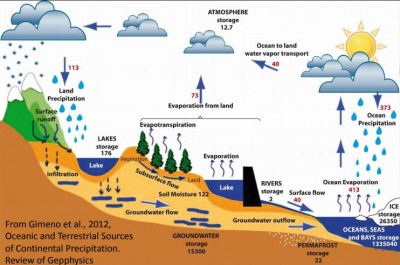Moisture Transport: from Evaporation to Precipitation

Given the importance of global climate change, an understanding of the nature and intensity of the hydrological cycle and of its development over time is one of the most pressing challenges currently faced by mankind. Although the atmosphere contains only a small proportion of the total global water, it nevertheless plays a key role in connecting the major reservoirs of the oceans, lakes, soils, inland and sea ice, and rivers via the transport of moisture, evapotranspiration, and precipitation.
The hydrological cycle may be summarized as the evaporation of moisture at one location and precipitation elsewhere, balanced by the atmospheric, oceanic, and hydrological transport of water. In oceanic regions, the rate of evaporation generally exceeds the rate of precipitation, and oceans therefore represent a net source of moisture that is then transported by the atmosphere to the continents; landmasses act as net sinks of atmospheric moisture where precipitation exceeds evapotranspiration. Surface water then feeds rivers, groundwater, and other bodies that discharge into the ocean, thereby completing the cycle.
In global terms, the hydrological cycle is responsible for an annual rate of evaporation of about half a million cubic kilometers of water, around 86% of which is from the oceans, with the remainder having its origin in the continents.
The trajectory-based (Lagrangian) methods used to identify sources of moisture available for precipitation have been widely used to assess both global and regional sources.
Gimeno L, Vázquez M, Eiras-Barca J, Sorí R, Stojanovic M, Algarra I, Nieto R, Ramos AM, Durán-Quesada AM, Dominguez F (2020) Recent progress on the sources of continental precipitation as revealed by moisture transport analysis, Earth Science Reviews 201 https://doi.org/10.1016/j.
Gimeno L, Stohl A, Trigo RM, Dominguez F, Yoshimura K, Yu L, Drumond A, Durán-Quesada AM, Nieto R (2012), Oceanic and terrestrial sources of continental precipitation, Rev. Geophys., 50, RG4003, doi:10.1029/2012RG000389
The EPhysLab group during the last decades puts its effort and resources to understand better the source-sink moisture relationships around the globe and the meteorological systems involved.
Active Project:
SETESTRELO - High-resolution assessment of North Atlantic moisture transport in current climate and CMIP-6 future projections, PI: Raquel Nieto and Luis Gimeno
Ministry of Science, Innovation and Universities, Spain, 2022-2025.
Present and future climate humidity transport over Central and South America: Mechanisms, extremes and attribution of changes. PI: Rogert Sorí
Xunta de Galicia - ERDF, Spain, 2024-2027.
MARINA - Mapping Drought Risks in Water-Stressed Regions of North Africa: An Integrated Approach. PI: Milica Stojanovic. ESA EO AFRICA R&D Facility in collaboration with the African Union Commission (AUC). 2024 – 2026
HighResTC-CAR - High-resolution downscaling of tropical cyclones in the Caribbean region. CORDEX FPS proposal. PI: Albenis Pérez-Alarcón. 2025-2030.
Last Projects:
LAGRIMA - LAGRangian analysis of the Impact on the global hydrological cycle of the Major Mechanisms of Atmospheric Moisture Transport, 2019-2022
ESA CCI - EUROPEAN SPACE AGENCY, CLIMATE CHANGE INITIATIVE – WATER VAPOR, 2020-2022
Research topics:


